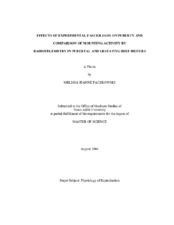| dc.contributor.advisor | Forrest, David | |
| dc.creator | Paczkowski, Melissa Jeanne | |
| dc.date.accessioned | 2005-11-01T15:52:11Z | |
| dc.date.available | 2005-11-01T15:52:11Z | |
| dc.date.created | 2004-08 | |
| dc.date.issued | 2005-11-01 | |
| dc.identifier.uri | https://hdl.handle.net/1969.1/2796 | |
| dc.description.abstract | Angus-sired heifers were allotted by age (mean=4 mo), BW (mean=135 kg), and sire (n=4) to either a control (n=10) or infected group (n=11; 600 metacercariae of Fasciola hepatica, intraruminally) to test our hypothesis that puberty is delayed by experimental fascioliasis. Blood samples were collected biweekly for analysis of steroid hormone concentrations. At 2-wk intervals, BW was recorded, and samples were collected for analysis of liver enzymes and serum proteins and fecal egg counts. A radiotelemetry system (HeatWatch??) was used to detect estrus and ovulation was confirmed by an elevation in serum progesterone (P4) after estrus. Heifers were artificially inseminated (AI) at the second observed estrus. Serum γ-glutamyl transpeptidase (GGT) and aspartate aminotransferase (AST) increased (p<0.0008) between day 0 and 112 in the infected group. Serum estradiol (E2) and P4 concentrations did not differ (p>0.1) between treatment groups. Mean age at puberty was 10 days later (p>0.1) in the infected group. Conception rate did not differ between control and infected heifers.
The HeatWatch?? data were used to compare mounting activity during estrus in pubertal and gestating heifers. Mean duration of estrus was longer (p<0.01) for the second than for the pubertal estrus, though total mount duration and number of mounts did not differ. Number of mounts at second estrus was greater (p<0.05) for heifers that conceived (n=9). Mean duration of estrus and total mount duration at second estrus were not associated with pregnancy outcome. Estrus events were detected in all nine heifers during pregnancy (total=73). A majority (75%) of the interestrus intervals during gestation was <17 d. Number of mounts (p=0.035) and total duration of mounts (p=0.022) at second estrus were predictive of number of mounts during gestation.
Experimental infection of Fasciola hepatica did not alter serum steroid hormone concentration or delay pubertal development in heifers. Estrus duration was longer for the second estrus compared to the pubertal estrus, and the number of mounts received during the second estrus was greater in heifers that did conceive to AI. Estrus events were detected in each heifer during pregnancy; however, a normal interestrus interval occurred in only 10% of the estrus events. | en |
| dc.format.extent | 569226 bytes | en |
| dc.format.medium | electronic | en |
| dc.format.mimetype | application/pdf | |
| dc.language.iso | en_US | |
| dc.publisher | Texas A&M University | |
| dc.subject | Fascioliasis | en |
| dc.subject | Puberty | en |
| dc.subject | Heifers | en |
| dc.subject | HeatWatch | en |
| dc.title | Effects of experimental fascioliasis on puberty and comparison of mounting activity by radiotelemetry in pubertal and gestating beef heifers | en |
| dc.type | Book | en |
| dc.type | Thesis | en |
| thesis.degree.department | Animal Science | en |
| thesis.degree.discipline | Physiology of Reproduction | en |
| thesis.degree.grantor | Texas A&M University | en |
| thesis.degree.name | Master of Science | en |
| thesis.degree.level | Masters | en |
| dc.contributor.committeeMember | Magee, Derry | |
| dc.contributor.committeeMember | Thompson, James | |
| dc.contributor.committeeMember | Craig, Thomas | |
| dc.type.genre | Electronic Thesis | en |
| dc.type.material | text | en |
| dc.format.digitalOrigin | born digital | en |


